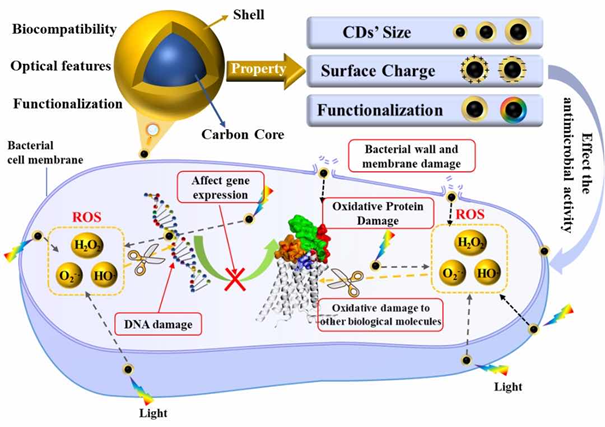文献领读No.16:生命学院博士领航带你走进生命科学学术前沿
欢迎来到暑期学习不停步的生命世界!!!
如何利用器官芯片技术开发帕金森相关模型?模拟皮肤传入群体响应的算法如何提高机器人辅助手术中触觉反馈的性能?小胶质细胞和阿尔茨海默症有什么关系?如何利用机器学习实现自动表面异常检测?噬菌体免疫途径的结构和生化机制是什么样的?碳点在抗菌领域有什么样的应用?
本期线上博士领航活动为大家邀请到了六位生命学院的21级博士,将于2022年7月18日(周一)上午9:00通过线上文献领读(腾讯会议:121-870-513)的方式来给大家解答这几个问题。
当然,大家还能向在科研方面有资深经验的学长、学姐们咨询其他科研相关内容哦,机会难得,还不赶紧来加入吧~
分享人
闫然然
Modeling alpha-synuclein pathology in a human brain-chip to assess BBB disruption
Parkinson's disease and related synucleinopathies are characterized by the abnormal accumulation of alpha-synuclein aggregates, loss of dopaminergic neurons, and gliosis of the substantia nigra. Although clinical evidence and in vitro studies indicate disruption of the Blood-Brain Barrier in Parkinson's disease, the mechanisms mediating the endothelial dysfunction is not well understood. Here we leveraged the Organs-on-Chips technology to develop a human Brain-Chip representative of the substantia nigra area of the brain containing dopaminergic neurons, astrocytes, microglia, pericytes, and microvascular brain endothelial cells, cultured under fluid flow. Our αSyn fibril-induced model was capable of reproducing several key aspects of Parkinson's disease, including accumulation of phosphorylated αSyn (pSer129-αSyn), mitochondrial impairment, neuroinflammation, and compromised barrier function. This model may enable research into the dynamics of cell-cell interactions in human synucleinopathies and serve as a testing platform for target identification and validation of novel therapeutics.
分享人
闫勇敢
Bio-inspired Haptic Feedback for Artificial Palpation in Robotic Surger
Adding haptic feedback has been reported to improve the outcome of minimally invasive robotic surgery. In this study, we seek to determine whether an algorithm based on simulating responses of a cutaneous afferent population can be implemented to improve the performance of presenting haptic feedback for robot-assisted surgery. We propose a bio-inspired controlling model to present vibration and force feedback to help surgeons localize underlying structures in phantom tissue. A single pair of actuators was controlled by outputs of a model of a population of cutaneous afferents based on the pressure signal from a single sensor embedded in surgical forceps. We recruited 25 subjects including 10 expert surgeons to evaluate the performance of the bio-inspired controlling model in an artificial palpation task using the da Vinci surgical robot. Among the control methods tested, the bio-inspired system was unique in allowing both novices and experts to easily identify the locations of all classes of tumors and did so with reduced contact force and tumor contact time. This work demonstrates the utility of our bio-inspired multi-modal feedback system, which resulted in superior performance for both novice and professional users, in comparison to a traditional linear and the existing piecewise discrete algorithms of haptic feedback.
分享人
谢真
Absence of microglia promotes diverse pathologies and early lethality in Alzheimer’s disease mice
Microglia are strongly implicated in the development and progression of Alzheimer’s disease (AD), yet their impact on pathology and lifespan remains unclear. Here we utilize a CSF1R hypomorphic mouse to generate a model of AD that genetically lacks microglia. The resulting microglial-deficient mice exhibit a profound shift from parenchymal amyloid plaques to cerebral amyloid angiopathy (CAA), which is accompanied by numerous transcriptional changes, greatly increased brain calcification and hemorrhages, and premature lethality. Remarkably, a single injection of wild-type microglia into adult mice repopulates the microglial niche and prevents each of these pathological changes. Taken together, these results indicate the protective functions of microglia in reducing CAA, blood-brain barrier dysfunction, and brain calcification. To further understand the clinical implications of these findings, human AD tissue and iPSC-microglia were examined, providing evidence that microglia phagocytose calcium crystals, and this process is impaired by loss of the AD risk gene, TREM2.
分享人
刘思宇
Segmentation-based deep-learning approach for surface-defectdetection
Automated surface-anomaly detection using machine learning has become an interesting and promising area of research, with a very high and direct impact on the application domain of visual inspection. Deep-learning methods have become the most suitable approaches for this task. They allow the inspection system to learn to detect the surface anomaly by simply showing it a number of exemplar images. This paper presents a segmentation-based deep-learning architecture that is designed for the detection and segmentation of surface anomalies and is demonstrated on a specific domain of surface-crack detection. The design of the architecture enables the model to be trained using a small number of samples, which is an important requirement for practical applications. The proposed model is compared with the related deep-learning methods, including the state-of-the-art commercial software, showing that the proposed approach outperforms the related methods on the specific domain of surface-crack detection. The large number of experiments also shed light on the required precision of the annotation, the number of required training samples and on the required computational cost. Experiments are performed on a newly created dataset based on a real-world quality control case and demonstrates that the proposed approach is able to learn on a small number of defected surfaces, using only approximately 25-30 defective training samples, instead of hundreds or thousands, which is usually the case in deep-learning applications. This makes the deep-learning method practical for use in industry where the number of available defective samples is limited. The dataset is also made publicly available to encourage the development and evaluation of new methods for surface-defect detection.
分享人
尹森
HORMA Domain Proteins and a Trip13-like ATPase Regulate Bacterial cGAS-like Enzymes to Mediate Bacteriophage Immunity
Bacteria are continually challenged by foreign invaders, including bacteriophages, and have evolved a variety of defenses against these invaders. Here, we describe the structural and biochemical mechanisms of a bacteriophage immunity pathway found in a broad array of bacteria, including E. coli and Pseudomonas aeuginosa. This pathway uses eukaryotic like HORMA domain proteins that recognize specifific peptides, then bind and activate a cGAS/DncV-like nucleotidyltransferase (CD-NTase) to generate a cyclic triadenylate (cAAA) second messenger; cAAA in turn activates an endonuclease effector, NucC. Signaling is attenuated by a homolog of the AAA+ ATPase Pch2/TRIP13, which binds and disassembles the active HORMA-CD-NTase complex. When expressed in non-pathogenic E. coli, this pathway confers immunity against bacteriophage λ through an abortive infection mechanism. Our fifindings reveal the molecular mechanisms of a bacterial defense pathway integrating a cGAS-like nucleotidyltransfer ase with HORMA domain proteins for threat sensing through protein detection and negative regulation by a Trip13 ATPase.
分享人
赵晨
碳点在抗菌领域的应用
在新冠病毒肆虐全球的大背景下,越来越多的人们开始关注细菌、病毒等的致病性微生物对人类健康所造成的影响。如何快速有效的消灭致病性微生物,关乎着人类社会的健康与发展。抗生素作为20世纪人类最伟大的发明之一,拯救了无数由细菌、病毒感染而岌岌可危的生命。然而由于病毒的快速进化以及抗生素的滥用,越来越多的细菌产生耐药性。抗生素的短板也逐渐显现出来,比如其本身的生物毒性,加速病原体产生耐药性等等。因此新型抗菌剂的开发迫在眉睫。
碳点(CDs)作为新型零维碳基纳米材料,具备卓越的生物相容性,良好的水溶性,优异的光学性能,其在生物成像,生物传感,药物传递等的方向展现出良好的应用前景。此外,由于CDs表面具有丰富的官能团并具备光动力产生活性氧的能力,使其在对抗耐药菌和新发病毒等的方面具备得天独厚的优势。目前,已有报道称CDs具有对抗COVID-19的潜力。

时间:2022年7月18日(周一)上午9:00
地点:腾讯会议:121-870-513
会议链接:
https://meeting.tencent.com/dm/XZuuqKioU0dK